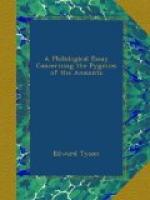(5.) The association of giants and dwarfs in certain places, even the confusion of the two races, seems somewhat difficult of explanation by this theory. In Ireland the distinction between the two classes is sharper than in other places, since, as Sir William Wilde pointed out, whilst every green rath in that island is consecrated to the fairies or “good people,” the remains attributed to the giants are of a different character and probably of a later date. In some places, however, a mound similar to those often connected with fairies is associated with a giant, as is the case at Sessay parish, near Thirsk,[A] and at Fyfield in Wiltshire. The chambered tumulus at Luckington is spoken of as the Giant’s Caves, and that at Nempnet in Somersetshire as the Fairy’s Toot. In Denmark, tumuli seem to be described indifferently as Zettestuer (Giants’ Chambers) or Troldestuer (Fairies’ Chambers).[B] In “Beowulf” a chambered tumulus is described, in the recesses of which were treasures watched over for three hundred years by a dragon. This barrow was of stone, and the work of giants.
Seah on enta geweorc, Looked on the giant’s work, hu etha stan-bogan, how the stone arches, stapulinn-faeste, on pillars fast, ece eoreth-reced the eternal earth-house innan healde. held within.
[Footnote A: Folk Lore, i. 130.]
[Footnote B: Flint Chips, p. 412.]
The mounds have sometimes been made by giants and afterwards inhabited by dwarfs, as in the case of the Nine-hills, already alluded to. In others, they are at the same time inhabited by giants, dwarfs, and others, as in the story of the Dwarf’s Banquet,[A] and still more markedly in the Wunderberg. “The celebrated Wunderberg, or Underberg, on the great moor near Salzburg, is the chief haunt of the Wild-women. The Wunderberg is said to be quite hollow, and supplied with stately palaces, churches, monasteries, gardens, and springs of gold and silver. Its inhabitants, beside the Wild-women, are little men, who have charge of the treasures it contains, and who at midnight repair to Salzburg to perform their devotions in the cathedral; giants, who used to come to the church of Groedich and exhort the people to lead a godly and pious life; and the great Emperor Charles V., with golden crown and sceptre, attended by knights and lords. His grey beard has twice encompassed the table at which he sits, and when it has the third time grown round it, the end of the world and the appearance of the Antichrist will take place."[B]
[Footnote A: Grimm ap. Keightley, 130.]
[Footnote B: Grimm ap. Keightley, 234.]
In the folk-tales of the Magyars we meet with a still more remarkable confusion between these two classes of beings. Some of the castles described in these stories are inhabited by giants, others by fairies. Again, the giants marry; their wives are fairies, so are their daughters. They had no male issue, as their race was doomed to extermination. They fall in love, and are fond of courting. Near Bikkfalva, in Haromszek, the people still point out the “Lover’s Bench” on a rock where the amorous giant of Csigavar used to meet his sweetheart, the “fairy of Veczeltetoe."[A]




